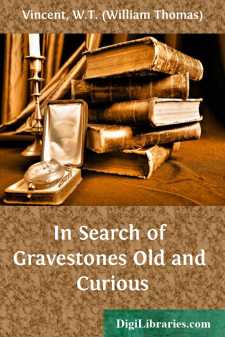Categories
- Antiques & Collectibles 13
- Architecture 36
- Art 48
- Bibles 22
- Biography & Autobiography 813
- Body, Mind & Spirit 142
- Business & Economics 28
- Children's Books 15
- Children's Fiction 12
- Computers 4
- Cooking 94
- Crafts & Hobbies 4
- Drama 346
- Education 46
- Family & Relationships 57
- Fiction 11828
- Games 19
- Gardening 17
- Health & Fitness 34
- History 1377
- House & Home 1
- Humor 147
- Juvenile Fiction 1873
- Juvenile Nonfiction 202
- Language Arts & Disciplines 88
- Law 16
- Literary Collections 686
- Literary Criticism 179
- Mathematics 13
- Medical 41
- Music 40
- Nature 179
- Non-Classifiable 1768
- Performing Arts 7
- Periodicals 1453
- Philosophy 64
- Photography 2
- Poetry 896
- Political Science 203
- Psychology 42
- Reference 154
- Religion 513
- Science 126
- Self-Help 84
- Social Science 81
- Sports & Recreation 34
- Study Aids 3
- Technology & Engineering 59
- Transportation 23
- Travel 463
- True Crime 29
In Search of Gravestones Old and Curious
Description:
Excerpt
CHAPTER I.
OLD GRAVESTONES.
I was sauntering about the churchyard at Newhaven in Sussex, reading the inscriptions on the tombs, when my eyes fell upon a headstone somewhat elaborately carved. Although aged, it was in good preservation, and without much trouble I succeeded in deciphering all the details and sketching the subject in my note-book. It is represented in Fig. 1.
FIG. 1—AT NEWHAVEN, SUSSEX.
The inscription below the design reads as follows:
"Here lyeth the remains of Andrew Brown,
who departed this life the 14th day of
January 1768, aged 66 years. Also of
Mary his wife, who departed this life the
3d day of July 1802, aged 88 years."
This was the first time I had been struck by an allegorical gravestone of a pronounced character.
The subject scarcely needs to be interpreted, being obviously intended to illustrate the well-known passage in the Burial Service: "For the trumpet shall sound, and the dead shall be raised ... then shall be brought to pass the saying that is written, Death is swallowed up in Victory. O death, where is thy sting? O grave, where is thy victory?" The reference in another ritual to the Lord of Life trampling the King of Terrors beneath his feet seems also to be indicated, and it will be noticed that the artist has employed a rather emphatic smile to pourtray triumph.
It was but natural to suppose that this work was the production of some local genius of the period, and I searched for other evidences of his skill. Not far away I found the next design, very nearly of the same date.
FIG. 2.—AT NEWHAVEN, SUSSEX.
The words below were:
"To the memory of Thomas, the son of
Thomas and Ann Alderton, who departed
this life the 10th day of April 1767, in the
13th year of his age."
The same artist almost of a certainty produced both of these figurative tombstones. The handicraft is similar, the idea in each is equally daring and grotesque, and the phraseology of the inscriptions is nearly identical. I thought both conceptions original and native to the place, but I do not think so now. In point of taste, the first, which is really second in order of date, is perhaps less questionable than the other. The hope of a joyful resurrection, however rudely displayed, may bring comfort to wounded hearts; but it is difficult to conceive the feelings of bereaved parents who could sanction the representation of a beloved boy, cut off in the brightest hour of life, coffined and skeletoned in the grave!
Above the coffin on Alderton's headstone is an ornament, apparently palms. It is not unusual to find such meaningless, or apparently meaningless, designs employed to fill in otherwise blank spaces, though symbols of death, eternity, and the future state are in plentiful command for such purposes. Something like this same ornament may be found on a very old flat stone in the churchyard of Widcombe, near Bath. It stretches the full width of the stone, and is in high relief, which has preserved it long after the accompanying inscription has vanished....


